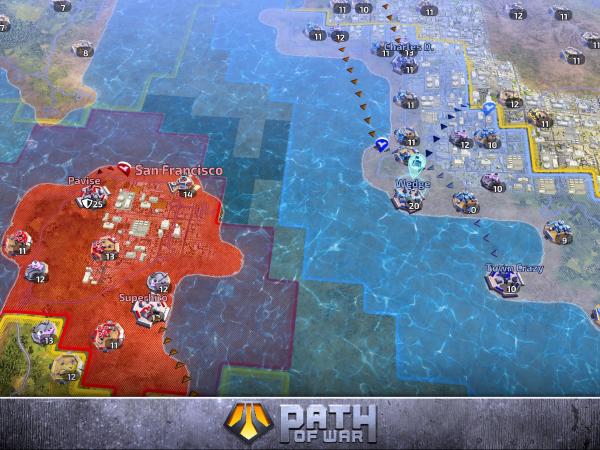Envision Entertainment is just over 2 years old, but its roots go back farther than that. The studio was originally Phenomic [founded in 1997], and later became EA Phenomic, creators of browser-based massively multiplayer strategy games like BattleForge and Command & Conquer: Tiberium Alliances [2012]. The latter of which is still in operation.
The company decided to bring its longtime experience to develop a strategy game called Path of War, which released today for mobile devices. In it, players must all make their way across 1:1 scale map of the United States (derived from real world geographic data), from the West Coast to Washington DC to take down a despotic leader. All the while, players build up their forces, make alliances and compete with each other for resources.
Martin Löhlein, Senior Producer at Envision Entertainment speaks to [a]listdaily about developing a game that fits in with Nexon’s vision of publishing games with a 10-year service expectation while tearing a path of destruction across the United States.
 Tell us a little about Path of War
Tell us a little about Path of War
Path of War is a tactical asynchronous real-time battle game, kind of like Clash of Clans (but with a completely different combat system), and it takes place on a synchronous MMO map, like in Game of War. Each world [server] supports 50,000 players on a 1:1 scale map of the United States, meaning that each game square is equal to one square mile of real space.
Once you really get engaged, and alliances battle each other, you could do some real long term planning. You could be plotting for two or three days before the attack of a key city. Some people have described it as chess-like, because you can make use of the strengths and weaknesses of different units in addition to forcing defenders into unfavorable positions using their movement rules.
As players progress and move across the world, they trigger story events that feed back into gameplay changes, like everyone getting powerful tanks for a period of time.
After so long in PC development, what made mobile the ideal platform?
The availability of these devices is just perfect for these types of games; ones where you engage with a lot of players over a long period of time. As your alliance moves across the US and focuses on different locations in real-time, so there’s always something happening in the world. Everything unfolds over a period of weeks or months.
With a PC, you sit down, dedicate a set period of time, and you’re out. If you’re not in front of your computer while your alliance is having a planning discussion, then you’re left out. With mobile, we have designed the game for players to drop in and out while still being able to keep track of what’s going on using an in-game messenger system that’s similar to Whatsapp, Google Hangouts, or Facebook Messenger — because that’s how people communicate using mobile — with option push notifications from individual channels. That way, you can follow conversations even when not in-game.
Then, if you have time, you can fire up the game within seconds to be part of the action or spectate.
As the game continues to grow, will new players have trouble getting in?
The game is based on a constant progression of players moving forward towards Washington DC Rewards from the area become less valuable the longer you stay in one place, which encourages you to move further east. The challenge is in how fast you can move across the map.
You’ll never be stuck, because whoever is in front of you will either move forward if he’s active, or you’ll become strong enough to defeat him and move past if he’s not. Plus, you can move south or north to find another way to break through.
Assuming you’re going at a swift pace, about how long does it take to reach DC?
From the testing we’ve done, and the way we’ve engineered the game, it should take roughly six months.

Mobile games are generally known for quick gameplay sessions, but Path of Warseems very involved. How do you reconcile that?
That is a common perception, and there is some truth to it, but with a twist. Mobile is indeed a platform where a lot of the sessions are meant to just kill a few minutes of time. But that doesn’t mean they’re exclusively played in that manner.
What we’ve seen in our tests is that players want to have some distraction, and not think too much if they only have a few minutes, but they also want to invest more time and thought into games they like. The most important thing is that whatever you do, whether it’s a quick session or not, it needs to contribute to some sort of overarching, persistent, progress.
There are different ways you can challenge yourself while playing Path of War. If you can do some resource raids if you just have a few minutes to kill, and still make a contribution to your alliance and overall progress. If you have a little more time to get involved, that’s when you dive in to expand your territory and take on more challenging targets. We’ve made sure that the game doesn’t require an extreme time investment to play competitively with others.
In our previous experience, we found that the most valuable players — those that keep alliances together, set goals for others, and make the game more enjoyable in general — are people who are successful in real life. They usually have a family and a job, which means they can’t spend an infinite amount of time in the game. So, you can still be competitive even if you play a few brief sessions a day, and keep up with those who can play for much longer periods.
In what ways does Path of War fit into Nexon’s plan for releasing games with a 10 year service expectation?
I don’t want to describe what happens after you reach Washington DC, but what I’d like to point to our history, especially the browser games. Command & Conquer: Tiberium Alliances is still running, and still has players from its first weeks.
The important thing for us is to listen to the community to see what the game needs and how we can extend the gameplay. A core thing for us is creating systems and mechanics that can be extended for quite a while and to quite some depth. Our units, their upgrade options, and the fact that we’re using real world data instead of designing levels opens up a lot of options.
The interesting thing will be releasing the game worldwide, connecting with players, and seeing where we can take the game in the long run, especially through the social components. We’ve seen that people who engage in this kind of alliance gameplay tend to form strong bonds that endure over a long period of time.

